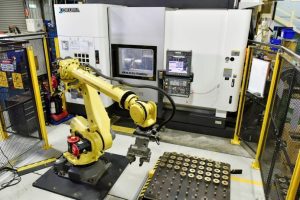Grifco strengthens local production and skills with tech investment

In 2015, Australia’s leading manufacturer of commercial door openers, Grifco, was under pressure to increase production to keep pace with demand. With future growth both locally and our plans to increase export capabilities, we needed to make a change to increase our capacity.
The then 101-year-old Grifco was committed to creating a new way of manufacturing that could increase capacity and productivity, without replacing the jobs of hard-working Aussies.
To grow the business and retain a sustainable workforce, the introduction of automation was key to future-proofing the Grifco brand. echnology has both increased production capabilities and enriched the skills and employment prospects for employees at Grifco’s Central Coast factory in Gosford.
Grifco’s first Robotic Machining Cell
Grifco started its automation journey over six years ago, with the first Robotic Machining Cell.
The robot is used to machine the gears and shafts that make up the internal components of our gearboxes. The first robot was so successful we purchased another robotic machine in 2019.
“Often people hear automation and robotics and think that means we are reducing our workforce, however, it actually increases capacity and productivity. Adopting factory robots is an area where Australia lags behind other developed nations, and I think this needs to change,” says Graeme Sheekey, Grifco’s Head of Operations in Oceania.
Automation halves manufacturing time
Machining Supervisor Tom McNamara says that the introduction of automation has greatly increase productivity and decreased the manufacturing cycle time.
“We brought the robot into the production process to minimise manual labour and free up team members so they could focus on other priorities within their area. It has not only decreased the manufacturing cycle times by half, it has also allowed staff to be cross trained in other departments.”
According to Tom, the introduction of automatic technology was initially daunting for some members of the workforce, who were worried that there would be a reduction in staff. However, the technology has allowed the team to be more productive and enhance their skills to achieve their career goals.
“Looking back 12 months, we were doing a lot of overtime and we could not have actually done any more machining. Now, with this robotic cell, we have increased our capacity and productivity of our workforce,” says Tom.
“Utilising robotic technology has allowed us to lower our operating costs, improve workplace safety, reduce our factory lead times and increase our production output. Operations in each cell can continue when everyone has gone home for the night, as they don’t need human oversight,” says Tom.
Looking to the future
The company’s modernisation efforts so far have seen Grifco claim the Manufacturer of the Year prize at the Hunter Manufacturing Awards in 2019, and the 2020 Excellence in Sustainable Operations award.
“We’re investing in the future of manufacturing here on the Central Coast and we are committed to supporting our customers, our team and the environment in everything we do. We’re hoping to continue to increase our capacity by investing in more automation for our manufacturing process,” concludes Graeme.
